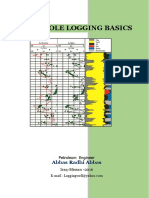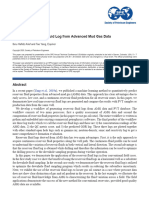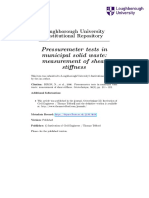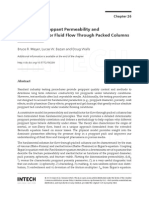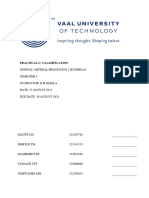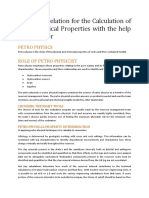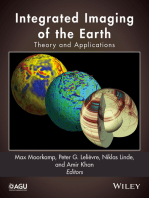3 Density Log
3 Density Log
Uploaded by
Mostafa IbrahimCopyright:
Available Formats
3 Density Log
3 Density Log
Uploaded by
Mostafa IbrahimCopyright
Available Formats
Share this document
Did you find this document useful?
Is this content inappropriate?
Copyright:
Available Formats
3 Density Log
3 Density Log
Uploaded by
Mostafa IbrahimCopyright:
Available Formats
Dr. Raed H.
Allawi
---------------------------------------------------------------------------------------------------------------------
DENSITY LOG
Density is measured in grams per cubic centimeter, g/cm3 (or Kg/m3 or Mg/m3),
and is indicated by the Greek letter 𝜌 (rho). Two separate density values are used by
the density log: the bulk density (𝜌b or RHOB) and the matrix density (𝜌ma). The
bulk density is the density of the entire formation (solid and fluid parts) as measured
by the logging tool. The matrix density is the density of the solid framework of the
rock. It may be thought of as the density of a particular rock type (e.g., limestone or
sandstone) that has no porosity. Since the late 1970s, the density log has also been
used for the photoelectric-effect measurement (Pe, PE, or PEF) to determine
lithology of a formation. The density log can assist the geologist to:
➢ identify evaporite minerals
➢ detect gas-bearing zones
➢ determine hydrocarbon density
➢ evaluate shaly-sand reservoirs and complex lithologies (Schlumberger,
1972)
The density logging tool has a relatively shallow depth of investigation, and as a
result, is held against the side of the borehole during logging to maximize its
response to the formation. The tool is comprised of a medium-energy gamma ray
source (cobalt 60, cesium 137, or in some newer designs, an accelerator-based
source). Two gamma ray detectors provide some measure of compensation for
borehole conditions (similar to the sonic logging tool).
When the emitted gamma rays collide with electrons in the formation, the collisions
result in a loss of energy from the gamma ray particle. The scattered gamma rays
that return to the detectors in the tool are measured in two energy ranges. The number
of returning gamma rays in the higher energy range, affected by Compton scattering,
is proportional to the electron density of the formation. For most earth materials of
interest in hydrocarbon exploration, the electron density is related to formation bulk
density through a constant (Tittman and Wahl, 1965), and the bulk density is related
to porosity. Gamma ray interactions in the lower energy range are governed by the
photoelectric effect. The response from this energy range is strongly dependent on
lithology and only very slightly dependent on porosity.
March 26, 2022 1
Dr. Raed H. Allawi
---------------------------------------------------------------------------------------------------------------------
The bulk-density curve (RHOB) is recorded in tracks 2 and 3 (Figure 4.3). The
photoelectric-effect curve (Pe in barns per electron, b/e) is displayed in either track
2 or track 3, with its placement set to minimize its overlap with the bulk-density
curve. A correction curve (DRHO in g/cm3 or Kg/m3), is also displayed in either
track 2 or track 3 (Figure 4.3). This curve indicates how much correction has been
added to the bulk-density curve during processing due to borehole effects (primarily
mudcake thickness) and is used primarily as a quality-control indicator. Whenever
the correction curve (DRHO) exceeds 0.20 g/cm3, the value of the bulk density
obtained from the bulkdensity curve (RHOB) should be considered suspect and
possibly invalid. A density-derived porosity curve (DPHI) is sometimes present in
tracks 2 and 3 along with the bulk-density (RHOB) and correction (DRHO) curves.
Track 1 usually contains a gamma ray log and a caliper (Figure 4.3).
The photoelectric-effect curve appeared as part of the second-generation density
tools, which are commonly referred to as Litho or Spectral tools and were introduced
around 1978. Formation bulk density (𝜌b) is a function of matrix density, porosity,
and density of the fluid in the pores (saltwater mud, freshwater mud, or
hydrocarbons). To determine density porosity, either by chart (Figure 4.4) or by
calculation, the matrix density (Table 1) and type of fluid in the formation must be
known. The formula for calculating density porosity is:
March 26, 2022 2
Dr. Raed H. Allawi
---------------------------------------------------------------------------------------------------------------------
Importance of Correct 𝝆ma and 𝝆fl values
A computer in the logging unit calculates density porosity from the measured bulk
density of the formation using Equation 4.7. The wellsite geologist or logging unit
engineer specifies the matrix and fluid densities that are to be used. If the formation’s
actual matrix density (𝝆ma) is less than the matrix density used to calculate the
porosity [e.g., calculating porosity of a sandstone (𝝆ma = 2.64 g/cm3) using a
limestone matrix density (𝝆ma = 2.71 g/cm3)], the log shows a calculated porosity
that is higher than the actual porosity of the formation. If the formation’s actual fluid
density is less than the fluid density used to calculate the porosity [e.g., calculating
the porosity of a saltwater filled formation (𝝆fl = 1.1 g/cm3) using a freshwater value
(𝝆fl = 1.0 g/cm3)], the log shows a calculated porosity that is lower than the actual
porosity of the formation. Because of the wider range of matrix-density values than
fluid-density values, errors in estimating the matrix density have a larger impact on
the calculated porosity.
March 26, 2022 3
Dr. Raed H. Allawi
---------------------------------------------------------------------------------------------------------------------
March 26, 2022 4
Dr. Raed H. Allawi
---------------------------------------------------------------------------------------------------------------------
March 26, 2022 5
Dr. Raed H. Allawi
---------------------------------------------------------------------------------------------------------------------
Hydrocarbon Effects
Where invasion of a formation is shallow, the low density of the formation’s
hydrocarbons causes the calculated density porosity to be greater than the actual
porosity. Oil does not significantly affect density porosity, but gas does (gas effect).
Hilchie (1978) suggests using a gas density of 0.7 g/cm3 for fluid density (𝝆fl) in
the density-porosity formula if gas density is unknown. Because the presence of oil
has little effect on the density log, this tool usually provides the best indication of
porosity in liquid-filled holes.
Heavy Minerals
Any time the bulk density of a formation (𝝆b) is greater than the assumed matrix
density (𝝆ma) of the formation [e.g., when measurements are made in an
anhydrite (𝝆ma = 2.96 g/cm3) but are recorded using a limestone matrix (𝝆ma =
2.71 g/cm3)], the resulting density porosity is negative. It is important to note that
in cases like this the logging tool is operating properly, but the assumptions made in
the conversion between bulk density and density porosity are incorrect. In cases like
this, where the porosity is clearly erroneous (because it is negative), the log still
yields good information. Negative density porosity is often a good indication of the
presence of anhydrite or other heavy minerals, as shown in Figure 4.5 over the
intervals 11,550 to 11,567 ft and 11,600 to 11,618 ft. Powdered barite is commonly
added to mud to increase mud density. When heavy muds are used
(e.g., 14 lb/gal), the high Pe of the barite (Table 4.2) in the mud can mask the Pe of
the adjacent rock layers.
NEUTRON LOG
Neutron logs are porosity logs that measure the hydrogen concentration in a
formation. In clean formations (i.e., shale-free) where the porosity is filled
with water or oil, the neutron log measures liquidfilled porosity (∅N, PHIN, or
NPHI). Neutrons are created from a chemical source in the neutron logging tool. The
chemical source is usually a mixture of americium and beryllium which
continuously emit neutrons. When these neutrons collide with the nuclei of the
formation the neutron loses some of its energy. With enough collisions, the neutron
is absorbed by a nucleus and a gamma ray is emitted. Because the hydrogen atom is
almost equal in mass to the neutron, maximum energy loss occurs when the
March 26, 2022 6
Dr. Raed H. Allawi
---------------------------------------------------------------------------------------------------------------------
neutron collides with a hydrogen atom. Therefore, the energy loss is dominated by
the formation’s hydrogen concentration. Because hydrogen in a porous formation is
concentrated in the fluid-filled pores, energy loss can be related to the formation’s
porosity.
The neutron curves are commonly displayed over tracks 2 and 3, in units referenced
to a specific lithology (usually either limestone or sandstone, depending on the
geologic environment expected to be encountered), as illustrated in Figure 4.5.
Neutron log responses vary, depending on:
• differences in detector types and what they detect (gamma rays and/or neutrons of
different energies)
• spacing between source and detector
• lithology (i.e., sandstone, limestone, and dolomite)
While the variations due to detector types and tool design are fixed (and are
accounted for in the data processing), the variations in response due to lithology
must be accounted for by using the appropriate charts (Figures 4.6 and 4.7). A
geologist should remember that the responses of different neutron logs differ from
each other (unlike all other logs) and must be interpreted from the specific chart
designed for a specific log (i.e., Schlumberger charts for Schlumberger logs
and Halliburton charts for Halliburton logs). The reason for this is that while other
logs are calibrated in basic physical units, neutron logs are not (Dresser
Atlas, 1975). Table 4.11 shows the results of lithology corrections that are made to
neutron measurements using the correct and incorrect charts for the specific neutron
tool.
The first neutron logs detected the gamma rays that were products of neutron capture
by formation nuclei. Initially, each logging company had its own calibration system,
but eventually the American Petroleum Institute (API) developed calibration pits to
provide a common standard for measurement (Serra, 1984).
Generally, these logs were displayed in counts per second (cps) or API Neutron
Units rather than porosity. Although charts to convert from displayed units to
porosity exist (Bassiouni, 1994), arbitrary conversions using core data or estimated
formation porosities have most often been used. It should be noted that the neutron
log response is inversely proportional to porosity so that low-measurement unit
March 26, 2022 7
Dr. Raed H. Allawi
---------------------------------------------------------------------------------------------------------------------
values correspond to high porosities, and high-measurement unit values
correspond to low porosities. The first modern neutron log (where porosity was
directly displayed) was the sidewall neutron log. Like the density log (and for the
same reason of limited depth of investigation), the sidewall neutron log has
both the source and detector in a pad that is pushed against the side of the borehole.
Although the sidewall neutron log was relatively insensitive to lithologic
effects, it was sensitive to borehole effects, such as rugosity (roughness) which
caused measurement difficulties. The most commonly used neutron log is the
compensated neutron log which has a neutron source and two detectors. Like the
sidewall neutron log, it directly displays values of porosity. The advantage of
compensated neutron logs over sidewall neutron logs is that they are less affected by
borehole irregularities. Both the sidewall and compensated neutron logs can
be recorded in apparent limestone, sandstone, or dolomite porosity units. If a
formation is limestone, and the neutron log is recorded in apparent limestone
porosity units, apparent porosity is equal to true porosity. However, when the
lithology of a formation is sandstone or dolomite, apparent limestone porosity
must be corrected to true porosity by using the appropriate chart (Figure 4.6
illustrates the lithology corrections for one model of Halliburton neutron log, and
Figure 4.7 the corrections for a Schlumberger neutron log). The procedure is
identical for each of the charts and is shown in Figures 4.6 and 4.7. Neutron-porosity
values from selected depths on the log in Figure 4.5 are listed in Table 4.9. Those
values are used in the chart in Figure 4.6 to determine sonic porosity, which is listed
in Table 4.10.
Hydrocarbon effects
Whenever pores are filled with gas rather than oil or water, the reported neutron
porosity is less than the actual formation porosity. This occurs because there is
a lower concentration of hydrogen in gas than in oil or water. This lower
concentration is not accounted for by the processing software of the logging tool,
and thus is interpreted as low porosity. A decrease in neutron porosity by the
presence of gas is called gas effect.
Shale Effect
Whenever clays are part of the formation matrix, the reported neutron porosity is
greater than the actual formation porosity. This occurs because the hydrogen
March 26, 2022 8
Dr. Raed H. Allawi
---------------------------------------------------------------------------------------------------------------------
that is within the clay’s structure and in the water bound to the clay is sensed in
addition to the hydrogen in the pore space. Because the processing software of
the logging tool expects all hydrogen in the formation to reside in the pores, the extra
hydrogen is interpreted as being part of the porosity. An increase in neutron
porosity by the presence of clays is called shale effect.
POROSITY MEASUREMENT COMBINATIONS
Although the advent of porosity logs provided a substantial improvement in log
interpretation, the significant change, from a geological viewpoint, was the
development of interpretive techniques that combined the measurements from
different porosity tools. With combinations of two or three measurements, lithology
could be interpreted (rather than having to be known) and a better estimate of
porosity produced. The interpretation of lithology and porosity is accomplished
through crossplots. These are x-y plots of the quantities of interest, usually overlain
with lines for “pure” lithologies (normally sandstone, limestone, and
dolomite) with porosity indicated on each lithology line (e.g., Figure 4.11).
Neutron-density Combination: Quick-look Lithology and Porosity
The combination of the neutron and density measurements is probably the most
widely used porosity log combination. The neutron-density log display consists of
neutron-porosity (NPHI) and density-porosity (DPHI) curves recorded in tracks 2
and 3 (Figure 4.5) and a caliper (CALI) and gamma ray (GR) in track 1.
Both the neutron and density curves are normally recorded in limestone porosity
units, however, porosity referenced to sandstone and dolomite can also be
recorded. The extensive use of the neutron-density combination may be due in part
to the fact that they were among the first logging tools that could be physically
combined and their data acquired in a single logging run. The response of the
combination is such that for reconnaissance evaluation one can forego the cross plot
and rely on recognition of the curve patterns (the position of the curves with respect
to each other) to quickly determine the most likely predominant lithology
and formation porosity. Figure 4.8 illustrates the use of the neutron-density
combination to determine formation lithology and to estimate porosity. The
reconnaissance technique works best with the following constraints:
March 26, 2022 9
Dr. Raed H. Allawi
---------------------------------------------------------------------------------------------------------------------
• Both the neutron and density curves are in porosity (decimal or percent) referenced
to limestone units.
• The formations are clean (no clays in the formations).
• There is no gas in the formations, only water or oil.
Using only the neutron-porosity and density-porosity curves, single lithologies can
be predicted with little ambiguity. Adding the gamma ray may help, as in identifying
dolomite from shale. In mixed lithologies, such as the sandy limestone and sandy
dolomite shown, even the addition of the gamma ray does not help. If the density
log is of the newer litho or spectral type and a photoelectric curve (Pe) is available,
the ambiguity can be further lessened, especially in the case of mixed lithologies.
The value of the Pe curve in mixed lithologies falls between the single lithology
value of each member, so some distinction can be made. Table 4.3 summarizes the
patterns and values for common lithologies. The estimation of porosity is equally
straightforward: the formation porosity can be estimated to within about 2 porosity
units (0.02) by taking the average of the neutron porosity and density porosity. In
areas of the world where sand and shale intervals predominate, the neutron and
density are referenced to sandstone rather than limestone to eliminate the need for
matrix conversion. (This also helps highlight the gas crossover effect described
below.) While Figure 4.8 focuses on lithology changes in clean (clay-free)
formations with widely varying lithologies, Figure 4.9 illustrates neutron and density
patterns in a variety of shaly sands, with both porosities referenced to sandstone. The
effects of gas and clays are greater on the neutron measurement than on the density,
with the neutron simultaneously being driven lower by gas and
higher by clays in a shaly gassy formation. The exact location of the neutron curve
with respect to the density curve is determined by the amounts of clay and gas
present in the formation. Table 4.12 shows the quick-look lithology determination
in Figure 4.8 applied to the data in Figure 4.5.
Neutron-density Combination: Gas Detection
Another technique using the neutron and density logs and the identification of curve
patterns is that of gas identification. Gas in the pores causes the density
porosity to be too high (gas has a lower density than oil or water) and causes the
neutron porosity to be too low (there is a lower concentration of hydrogen atoms
March 26, 2022 10
Dr. Raed H. Allawi
---------------------------------------------------------------------------------------------------------------------
in gas than in oil or water). Figure 4.10 shows an example of a gas zone. In that zone,
the neutron porosity is less than the density porosity, and the two porosity curves
cross over each other. This is called crossover. The magnitude of the crossover (the
amount of separation between the curves) is qualitatively related to the gas
saturation, however, the crossover is more strongly influenced (again qualitatively)
by the formation pressure. Low-pressure zones, either at shallow depths or depleted
from production, tend to show large crossover. Neutron-density crossover can also
be caused by lithologic effects, as when the curves are displayed referenced to a
lithology that is different from the actual lithology of the formation. Figure 4.8
illustrates this in the sandstone formations with the curves displayed
referenced to limestone. It is important to check the log header for lithology-
reference information as well as knowing the actual lithology of the formation in
question before predicting the presence of gas from the log patterns only.
The porosity of a gas-bearing formation can be estimated by either form of the
following equation:
March 26, 2022 11
Dr. Raed H. Allawi
---------------------------------------------------------------------------------------------------------------------
Porosity Combinations: Crossplots
Crossplots are a graphical way to solve fairly complex relationships using two (or
three) porosity measurements to estimate formation lithology and porosity.
All these crossplots have the same general format: one measurement is displayed
along the x-axis, and another is displayed along the y-axis. The measurements are
either in porosity units referenced to limestone or, in the case of density and sonic
logs, they can be in the original measurement units (ρb in g/cm3 or Kg/m3 for
the density, and ∆t in sec/ft or sec/m for the sonic). Superimposed on the plot (as
an overlay) are pure lithology lines, usually sandstone, limestone, and
dolomite. Porosity is indicated along each of these lines. See Figure 4.11 as an
example. In the interpretation, the values of the two measurements of interest are
plotted on the crossplot. The intersection of those values on the plot determines
both the porosity and the lithology of the point. If the point lies between two
lithology lines, the lithology is taken as a mixture of those two lithologies (with the
dominant lithology being that of the line closest to the point). The porosity is
estimated by joining points of equal porosity on the two lithology lines and
interpolating between the lines of equal porosity. Figure 4.11 illustrates the
interpretive process. It should be noted that not all interpretations are
unique. In fact, the data often plot in such a way that there are two possible lithology
pairs, and the decision of which to choose lies with the interpreter’s knowledge
of the area (or the application of other data). In some plots, as noted below and shown
in the accompanying figures, the choice of lithologic pair significantly
affects the predicted porosity value. Other minerals can also be plotted on the
crossplot, as distinct points (rather than lines indicating varying porosity). Figure
4.11 shows the location of halite and anhydrite. Log values for other pure minerals
are available in the log interpretation chartbooks provided by most well log (wireline
and MWD) acquisition companies. Although the existence of pure (and thick)
beds of some minerals is very rare, the location of the mineral point on the crossplot
(and the shift of the data toward that point) may sometimes give some indication that
the mineral is present in the formation of interest Table 4.4 details the advantages
and limitations of each of the four crossplots. The crossplots are listed in
the order of preference of use, from top to bottom. Figures 4.11 to 4.14 and Tables
4.13 to 4.15 illustrate the determination of porosity and lithology using
the first three crossplot techniques in Table 4.4.
March 26, 2022 12
Dr. Raed H. Allawi
---------------------------------------------------------------------------------------------------------------------
Extending the Crossplot Technique
Given that the use of two porosity measurements can lead to the prediction of a more
lithologically complex subsurface (i.e., the formation described as a
two-mineral mixture), the natural extension is to use three measurements to estimate
a ternary mixture. There are two different techniques, with one having
two variations. Both techniques are more concerned with determining lithology than
with determining porosity, the porosity having been determined from
the previous two-measurement crossplots (usually the neutron-density).
March 26, 2022 13
Dr. Raed H. Allawi
---------------------------------------------------------------------------------------------------------------------
M-N Lithology Plots
This technique is the oldest of the three-measurement lithology techniques, and was
based on combining the three porosity measurements in such a way so that two
quantities could be used in a crossplot. The two calculated quantities are:
March 26, 2022 14
Dr. Raed H. Allawi
---------------------------------------------------------------------------------------------------------------------
Data plotted on this crossplot show the following patterns: For a single pure
mineralogy, the data plot around the point representing that mineralogy. For
binary mineral systems, the data plot along a line connecting the two mineralogical
members, with the location of the points along the line indicative of the mineral
mixture of each point. For ternary systems, the data plot in a triangle with the three-
member mineralogies as the vertices of the triangle, and with the location of each
data point in the triangle indicative of the mineral mixture of that point. Note that
porosity is not predicted from this plot but is determined from the earlier two-
component crossplots. Although two common mineral triangles are usually used as
examples (either quartz/calcite/dolomite or calcite/dolomite/anhydrite), any three
minerals that plot uniquely on the crossplot can be used. One need
not see data clustered around a particular mineral endpoint to sense the presence of
a mineral. The presence of small amounts of a mineral tend to draw the data
away from the primary mineral (or mineral mixture) and toward the secondary
mineral endpoint. Table 4.16 shows the calculation of M and N values
and the resulting lithology estimations from Figure 4.15.
March 26, 2022 15
Dr. Raed H. Allawi
---------------------------------------------------------------------------------------------------------------------
March 26, 2022 16
Dr. Raed H. Allawi
---------------------------------------------------------------------------------------------------------------------
March 26, 2022 17
Dr. Raed H. Allawi
---------------------------------------------------------------------------------------------------------------------
March 26, 2022 18
Dr. Raed H. Allawi
---------------------------------------------------------------------------------------------------------------------
March 26, 2022 19
Dr. Raed H. Allawi
---------------------------------------------------------------------------------------------------------------------
March 26, 2022 20
Dr. Raed H. Allawi
---------------------------------------------------------------------------------------------------------------------
March 26, 2022 21
Dr. Raed H. Allawi
---------------------------------------------------------------------------------------------------------------------
March 26, 2022 22
Dr. Raed H. Allawi
---------------------------------------------------------------------------------------------------------------------
March 26, 2022 23
Dr. Raed H. Allawi
---------------------------------------------------------------------------------------------------------------------
March 26, 2022 24
Dr. Raed H. Allawi
---------------------------------------------------------------------------------------------------------------------
March 26, 2022 25
Dr. Raed H. Allawi
---------------------------------------------------------------------------------------------------------------------
March 26, 2022 26
Dr. Raed H. Allawi
---------------------------------------------------------------------------------------------------------------------
March 26, 2022 27
Dr. Raed H. Allawi
---------------------------------------------------------------------------------------------------------------------
March 26, 2022 28
Dr. Raed H. Allawi
---------------------------------------------------------------------------------------------------------------------
March 26, 2022 29
Dr. Raed H. Allawi
---------------------------------------------------------------------------------------------------------------------
March 26, 2022 30
Dr. Raed H. Allawi
---------------------------------------------------------------------------------------------------------------------
March 26, 2022 31
You might also like
- Airport Handling Manual IATADocument14 pagesAirport Handling Manual IATACarlos Minaya22% (9)
- Graded Quiz Unit 6 - Attempt ReviewDocument11 pagesGraded Quiz Unit 6 - Attempt ReviewJulius Owuonda100% (2)
- Rocx GUIDocument34 pagesRocx GUIErick CruzNo ratings yet
- Cased Hole Logging Basics - Abbas RadhiDocument31 pagesCased Hole Logging Basics - Abbas RadhiAnyul Lozano Rodríguez100% (1)
- Bulk DensityDocument8 pagesBulk Densityjorge pasosNo ratings yet
- Cox - 1999 - Power, Value and Supply Chain Management PDFDocument9 pagesCox - 1999 - Power, Value and Supply Chain Management PDFAntonio Carlos RodriguesNo ratings yet
- Versaworks Mac Setup en r3Document16 pagesVersaworks Mac Setup en r3Jaime Anibal Lara VillegasNo ratings yet
- 6 Log InterpretationDocument5 pages6 Log InterpretationMostafa IbrahimNo ratings yet
- Bubble-Induced Entrainment Between Stratified Liquid LayersDocument16 pagesBubble-Induced Entrainment Between Stratified Liquid LayersEuler CauchiNo ratings yet
- New Approach To Calculate The Mud Invasion in Reservoirs Using Well Logs - Mariléa RibeiroDocument5 pagesNew Approach To Calculate The Mud Invasion in Reservoirs Using Well Logs - Mariléa RibeiroSuta VijayaNo ratings yet
- Otc 28052 MsDocument9 pagesOtc 28052 MsSain-Gio De-Anton LizardiNo ratings yet
- Estimation Lithology and Depositional Facies From Well LogsDocument24 pagesEstimation Lithology and Depositional Facies From Well Logsgeoahamza85No ratings yet
- Formation Evaluation During Mud Logging - PetroWikiDocument7 pagesFormation Evaluation During Mud Logging - PetroWikichris mkonoNo ratings yet
- Spe 124197Document23 pagesSpe 124197ahmad faisalNo ratings yet
- SPE-192240-MS: Mahmoud Eid, Ainul Abedeen, and Janardhan Kurri, HalliburtonDocument4 pagesSPE-192240-MS: Mahmoud Eid, Ainul Abedeen, and Janardhan Kurri, HalliburtonMiguel AngelNo ratings yet
- GGGGGGDocument154 pagesGGGGGGMohamed KamalNo ratings yet
- G-Invasion SBGF 3929 OjoDocument5 pagesG-Invasion SBGF 3929 OjoKehoma DíazNo ratings yet
- Answer All Questions: Assist. Prof. Hussein AliwiDocument2 pagesAnswer All Questions: Assist. Prof. Hussein Aliwihitham al-miedamahNo ratings yet
- Doc3Document57 pagesDoc3zainalabdenmortadaNo ratings yet
- Thesis Ringo12Document89 pagesThesis Ringo12All_n_CifuentesNo ratings yet
- THESIS DOCTOR OF PHILOSOPHY ZARGAR Ehssan 2017Document170 pagesTHESIS DOCTOR OF PHILOSOPHY ZARGAR Ehssan 2017Muhammad Rafiq RavinNo ratings yet
- Fully IntegratedDocument10 pagesFully IntegratedNuring Tyas WicaksonoNo ratings yet
- Intze Tank - Seismic Behaviour - SAP2000 PDFDocument7 pagesIntze Tank - Seismic Behaviour - SAP2000 PDFAnonymous fQLEF2tQpqNo ratings yet
- Hydraulic Flow UnitsDocument6 pagesHydraulic Flow UnitscoreabzNo ratings yet
- SPE 62922 History Matching Geostatistical Reservoir Models With Gradual Deformation MethodDocument13 pagesSPE 62922 History Matching Geostatistical Reservoir Models With Gradual Deformation MethodSamuel Espinoza GarciaNo ratings yet
- Chapter 3 A Geologists Guide To Geophysical Well Log AnalysisDocument9 pagesChapter 3 A Geologists Guide To Geophysical Well Log AnalysisOscar Javier Vera ZambranoNo ratings yet
- SPE 122594 Well Test Analysis in Naturally Fractured Gas Condensate Reservoirs Below Dew Point PressureDocument16 pagesSPE 122594 Well Test Analysis in Naturally Fractured Gas Condensate Reservoirs Below Dew Point PressureGabriel EduardoNo ratings yet
- Mathematical Modeling of Solids-Drilling Fluid Separation in Shale Shakers in Oil Fields - A State of Art ReviewDocument20 pagesMathematical Modeling of Solids-Drilling Fluid Separation in Shale Shakers in Oil Fields - A State of Art ReviewLuiz Augusto Da Cruz Meleiro100% (1)
- Spe 131787Document15 pagesSpe 131787downloader1983No ratings yet
- Response of Soils To Dynamic LoadingsDocument238 pagesResponse of Soils To Dynamic LoadingsxxxxNo ratings yet
- Spe 166279 MS PDocument15 pagesSpe 166279 MS PdancelikedaveNo ratings yet
- CDF ArticleDocument11 pagesCDF Articlefajar kusumaNo ratings yet
- Reservoir Delineation by Wireline Techiniquess - Goetz 1977Document40 pagesReservoir Delineation by Wireline Techiniquess - Goetz 1977Grim FandangoNo ratings yet
- Correlation Between Liquid Limit and Shrinkage LimitDocument7 pagesCorrelation Between Liquid Limit and Shrinkage LimitGerald MaregesiNo ratings yet
- Hafidzarief 2020Document14 pagesHafidzarief 2020Gilvandro CésarNo ratings yet
- Enhanced One Dimensional Modeling For Predicting Concentration of BOD in RiversDocument7 pagesEnhanced One Dimensional Modeling For Predicting Concentration of BOD in RiversAfrillia FahrinaNo ratings yet
- SPE 144335 A New Method For History Matching and Forecasting Shale Gas Reservoir Production Performance With A Dual Porosity ModelDocument15 pagesSPE 144335 A New Method For History Matching and Forecasting Shale Gas Reservoir Production Performance With A Dual Porosity ModelIbrahim ElsawyNo ratings yet
- Shah Et AlDocument27 pagesShah Et AlEby OkvaleyNo ratings yet
- A Review On Models For Evaluating Rock Petrophysical PropertiesDocument12 pagesA Review On Models For Evaluating Rock Petrophysical PropertiesJaka WibowoNo ratings yet
- Mnras0396 1066 2 PDFDocument9 pagesMnras0396 1066 2 PDFbNo ratings yet
- Log Derived Mechanical Properties and Rock Stress: Spwla Twenty-First Annual Logging Symposium, JULY 8-11Document12 pagesLog Derived Mechanical Properties and Rock Stress: Spwla Twenty-First Annual Logging Symposium, JULY 8-11CAMILO ANDRES BOHORQUEZ ESPARZANo ratings yet
- Density Log Dexter Tanabe 20000241Document15 pagesDensity Log Dexter Tanabe 20000241Dexter TanabeNo ratings yet
- SPE 153022 A Workflow For Modeling and Simulation of Hydraulic Fractures in Unconventional Gas ReservoirsDocument11 pagesSPE 153022 A Workflow For Modeling and Simulation of Hydraulic Fractures in Unconventional Gas Reservoirstomk2220No ratings yet
- Reservoir Management-Finel ReportDocument30 pagesReservoir Management-Finel Reportعلي حميد زغيرNo ratings yet
- A Framework For Improving The Ability To Understand and Predict The Performance of Heap Leach PilesDocument11 pagesA Framework For Improving The Ability To Understand and Predict The Performance of Heap Leach PilesAldoNo ratings yet
- Thesis Mercury Iodide PDFDocument4 pagesThesis Mercury Iodide PDFmariaparkslasvegas100% (2)
- SPE184484STU Adrian AdvancedProductionDataAnalysisinOilCarbonateReservoirsDocument25 pagesSPE184484STU Adrian AdvancedProductionDataAnalysisinOilCarbonateReservoirssemester5 upNo ratings yet
- The Optical and Microphysical Properties of Water Soluble AerosolsDocument14 pagesThe Optical and Microphysical Properties of Water Soluble AerosolstheijesNo ratings yet
- 1506051300le Minh LongDocument42 pages1506051300le Minh LongTri TruongNo ratings yet
- Pressuremeter Tests in Municipal Solid Waste Measurement of Shear Stiffness - DixonDocument14 pagesPressuremeter Tests in Municipal Solid Waste Measurement of Shear Stiffness - DixonSen HuNo ratings yet
- 3D AVO and Seismic Inversion in Maris Ines Oeste FieldDocument4 pages3D AVO and Seismic Inversion in Maris Ines Oeste FieldSandy Indra PNo ratings yet
- Time Depth ConvertionDocument6 pagesTime Depth Convertionahiezer8511No ratings yet
- 9 Log InterpretationDocument29 pages9 Log InterpretationSunny BbaNo ratings yet
- Hakso Zoback 2018 Shear Fractures and Production1 0Document23 pagesHakso Zoback 2018 Shear Fractures and Production1 0jijinyangNo ratings yet
- 780 2147 1 SMDocument17 pages780 2147 1 SMhari6622100% (1)
- Permeability TestingDocument36 pagesPermeability TestingThanh Nguyen100% (1)
- Beta FactorDocument22 pagesBeta Factoramramazon88No ratings yet
- Class 9 Worksheet 21_07_2021 (2)Document2 pagesClass 9 Worksheet 21_07_2021 (2)pruthivi raj beheraNo ratings yet
- Reconstruction and Prediction of Variations in the Open Solar Magnetic Flux and Interplanetary ConditionsDocument88 pagesReconstruction and Prediction of Variations in the Open Solar Magnetic Flux and Interplanetary ConditionsMohammed TahaNo ratings yet
- Classification Final ReportDocument17 pagesClassification Final ReportTivani RindelaniNo ratings yet
- Badhole FlagDocument9 pagesBadhole FlagPetro ManNo ratings yet
- Use of Correlation For The Calculation of Petro Physical Properties With The Help of ComputerDocument4 pagesUse of Correlation For The Calculation of Petro Physical Properties With The Help of ComputerZOHAIB AHMEDNo ratings yet
- Fundamentals of the Petrophysics of Oil and Gas ReservoirsFrom EverandFundamentals of the Petrophysics of Oil and Gas ReservoirsNo ratings yet
- Integrated Imaging of the Earth: Theory and ApplicationsFrom EverandIntegrated Imaging of the Earth: Theory and ApplicationsMax MoorkampNo ratings yet
- 4011 - متوسطة الفهود المسائية للبنينDocument4 pages4011 - متوسطة الفهود المسائية للبنينMostafa IbrahimNo ratings yet
- Well ControlDocument8 pagesWell ControlMostafa IbrahimNo ratings yet
- Well ControlDocument5 pagesWell ControlMostafa IbrahimNo ratings yet
- PipeDocument1 pagePipeMostafa IbrahimNo ratings yet
- SAND CONTENT TEST Thi QarDocument3 pagesSAND CONTENT TEST Thi QarMostafa IbrahimNo ratings yet
- SAP POWER Plant Presentation PDFDocument41 pagesSAP POWER Plant Presentation PDFtrade6001No ratings yet
- Spin Wave Dispersion Relation Engineering by Magnonic Crystals With Arbitrary SymmetryDocument8 pagesSpin Wave Dispersion Relation Engineering by Magnonic Crystals With Arbitrary SymmetryJose MatutesNo ratings yet
- Band 3-4. W8 - L15 - AfterclassDocument3 pagesBand 3-4. W8 - L15 - Afterclassnguyenminhthu29102001No ratings yet
- Project ReportDocument91 pagesProject ReportNidhi BadnalNo ratings yet
- Goblin Slayer - 15 (Yen Press)Document225 pagesGoblin Slayer - 15 (Yen Press)qwer50% (2)
- Load Frequency Control of Three Area Interconnected Hydro-Thermal Reheat Power System Using Artificial Intelligence and PI ControllersDocument15 pagesLoad Frequency Control of Three Area Interconnected Hydro-Thermal Reheat Power System Using Artificial Intelligence and PI Controllerskrahim01No ratings yet
- Sip Proposal ReportDocument1 pageSip Proposal ReportRitika PaulNo ratings yet
- Ferrari P. Planning Inclusive Yachts - A Novel Approach To Yacht Design, 2020Document172 pagesFerrari P. Planning Inclusive Yachts - A Novel Approach To Yacht Design, 2020VitBar100% (1)
- Almario M. Kaabay JR Christopher B. Babaran: Orig Nato Rev Ewed by Approved byDocument4 pagesAlmario M. Kaabay JR Christopher B. Babaran: Orig Nato Rev Ewed by Approved bymarcmustreNo ratings yet
- MAESTRO Midship Design Tutorial - 2010!12!09Document58 pagesMAESTRO Midship Design Tutorial - 2010!12!09nabiloucheNo ratings yet
- Types of Beams in ConstructionDocument7 pagesTypes of Beams in ConstructionJerico FloresNo ratings yet
- CyberPower DS PR1000-3000ERTXL2U en v4Document2 pagesCyberPower DS PR1000-3000ERTXL2U en v4gonzalomora324No ratings yet
- Republic of The Philippines Position Description Form DBM-CSC Form No. 1Document8 pagesRepublic of The Philippines Position Description Form DBM-CSC Form No. 1Lara Michelle Sanday BinudinNo ratings yet
- Theories of Educational Management PDFDocument25 pagesTheories of Educational Management PDFJose Belisar83% (6)
- Lovely School of Architecture and Design (LSAD)Document1 pageLovely School of Architecture and Design (LSAD)Ankit SenguptaNo ratings yet
- Om Marketing Mix To E-Marketing PDFDocument9 pagesOm Marketing Mix To E-Marketing PDFBeatrice ElenaNo ratings yet
- Malasakit Irr Draft As of Jan30Document23 pagesMalasakit Irr Draft As of Jan30Chosen TabanasNo ratings yet
- What Is The InventionDocument1 pageWhat Is The Inventiondubi dobbsNo ratings yet
- Leadership Practice QDocument19 pagesLeadership Practice QRandyNo ratings yet
- Datasheet 7446 PDFDocument6 pagesDatasheet 7446 PDFtaufikNo ratings yet
- APJ Abdul Kalam Technological University: Master of Architecture (Urban Design)Document34 pagesAPJ Abdul Kalam Technological University: Master of Architecture (Urban Design)Anjitha UdayanNo ratings yet
- Definition LawDocument13 pagesDefinition LawPrince FaithNo ratings yet
- Nationalism and German UnificationDocument4 pagesNationalism and German UnificationkrizalynNo ratings yet
- (Track 04) : Total ScoreDocument2 pages(Track 04) : Total ScoreJesus Enrique Hernandez HernandezNo ratings yet
- "Fairytale/ Fantasy" Lesson Plan: Language ArtsDocument1 page"Fairytale/ Fantasy" Lesson Plan: Language Artsapi-299176681No ratings yet
- UAS Gasal 1-Bahasa InggrisDocument2 pagesUAS Gasal 1-Bahasa InggrisHimawan Dwi75% (4)



